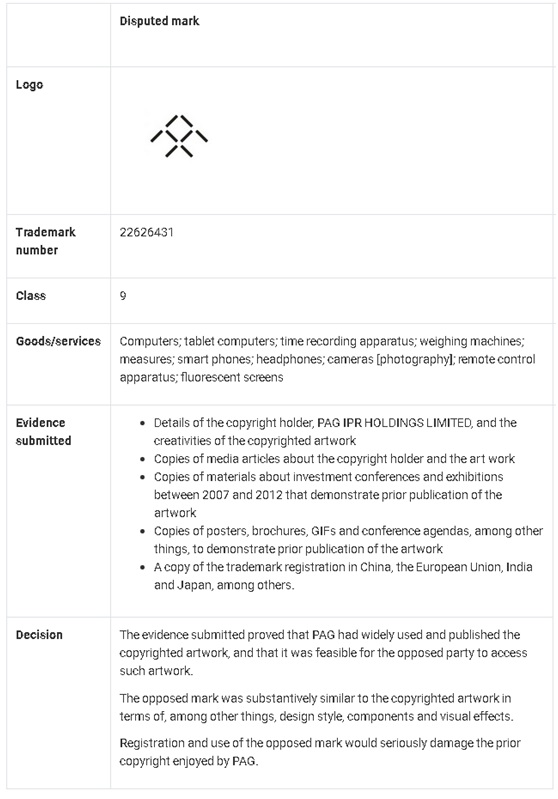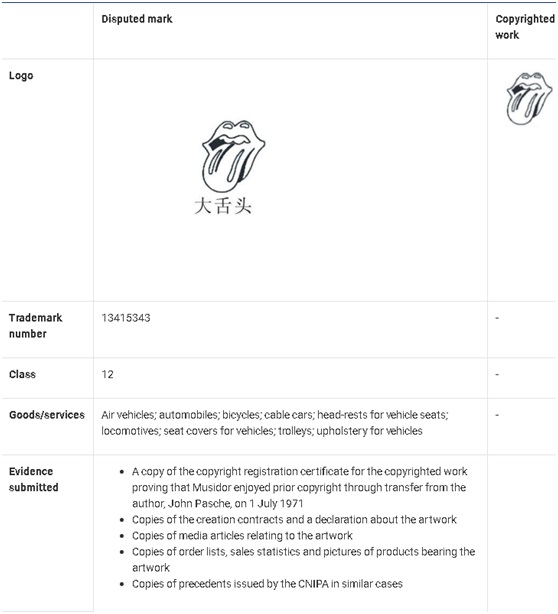Copyright protection is becoming a hot button issue across a wide variety of jurisdictions. In recent examination practice in mainland China, the number of cases relating to copyright has been growing vigorously. This article provides practical tips on how to seek protection and what steps to take in disputes between trademarks and copyrights.
Background
According to the China Trademark Law and Interpretations of the Supreme People's Court on Several Issues Concerning the Application of Laws to Trail of Copyright-involved Civil Dispute Cases, prior copyright is one of the strongest arguments that a rights holder can put forward in a trademark dispute. Recent examinations show that the courts and the China National IP Administration (CNIPA) are inclined to take prior copyright into account in determining how to protect a mark or verify an infringement.
Article 9 of the Trademark Law states: "The trademark applied for registration shall have distinctive characteristics for identification, and shall not conflict with the prior legitimate rights of others. The registrant of a trademark has the right to indicate the wording 'Registered Trademark' or a sign indicating that it is registered."
Meanwhile, Article 32 of the Trademark Law states: "The trademark application shall neither infringe upon another party's prior existing rights, nor be an improper means to register a trademark that is already in use by another party and enjoys substantial influence."
In addition, Article 7 of Interpretations of the Supreme People's Court on Several Issues Concerning the Application of Laws to Trail of Copyright-involved Civil Dispute Cases states: "The following documents provided by parties should be considered as evidence to prove prior copyright: manuscripts of works, origins, lawful publications, copyright registration certificate, declaration issued by certification authority, ownership contract, etc. The individuals, legal entities or associations, who sign on the works or products, should be considered as the real owner or interested party of the copyright, unless there is any contrary evidence."
Case studies
The following examples outline the evidence required in a dispute over a copyrighted work.
Case 1 – trademark opposition

Case 2 – trademark invalidation


As demonstrated above, if the rights holder can collect and submit evidence of use that proves its ownership of the copyright, as well as a certain reputation proving the likelihood of the owner of the disputed mark having access to its copyright, it will help the CNIPA or the court to verify and support the copyright in a trademark dispute.
In other words, when demonstrating exclusive rights in a prior mark, the burden of proof is slightly lower in copyright cases than in trademark cases. For this reason, copyright is becoming a strong and effective way to seek protection in trademark disputes.
According to the Chinese Trademark Examination Criteria, where a work in which the copyright is enjoyed by another person is applied for as a trademark, without the permission of the copyright holder, it will be determined as damage to the prior copyright, and the disputed mark must not be approved or must be declared invalid.
During examination, the following elements should be taken into account:
- The copyright holder has enjoyed the prior copyright before the application for registration of the disputed trademark;
- The disputed trademark is identical or substantially similar to the work of which the prior copyright is enjoyed by the copyright holder;
- The applicant of the disputed trademark has accessed or has the possibility to access the work of which the prior copyright is enjoyed by the copyright holder.
- The applicant of the disputed trademark has not obtained the permission of the copyright holder.
The following tips could help to win over an examiner.
Submit sufficient evidence of prior copyright
Prior enjoyment of a copyright means that the holder has obtained the copyright by means of creating and completing a work, or by way of inheritance or transfer, before the application date of the disputed mark.
Prior enjoyment of copyright can be proved with:
- a copyright registration certificate;
- evidence of material proving the prior public publishing of such work;
- evidence of material proving the prior ownership of the copyright by means of inheritance or transfer; or
- other material proving prior ownership of the copyright.
In this regard, a trademark registration certificate or a copyright registration certificate obtained later than the filing date of the disputed mark cannot be independently used as evidence of prior ownership of a copyright.
Hence, the copyright holder should file a new trademark application or copyright as soon as possible. Once the copyright or trademark has been filed, the rights holder should focus on collecting evidence of the earlier creation and publication of the mark in order to prove ownership.
Understand the meaning of 'work'
A 'work' means an object protected by the China Copyright Law.
In this regard, a copyright may protect only the design style or overall appearance of a work, rather than its inherent meaning or idea.
Thus, generally speaking, any words or common design will be vulnerable in practice.
How to prove ownership of copyright
Where the applicant of a disputed trademark can prove that its mark has been created and completed independently, the mark will not constitute damages to a prior copyright.
During examination, the burden of proof lies with the rights holder that claims that the registration and use of the disputed mark damages its prior copyright.
Additionally, in contrast to trademark protection, evidence generated outside China will also be considered. Therefore, in order to prove ownership of the copyright, evidence such as earlier manuscripts, contracts, invoices, publications in fashion shows or media articles, brochures and promotional materials around the world (although preferably in China) will be useful.
What is more, the copyright registration certificate will be used as prima facie evidence only. Therefore, the copyright holder must still provide documentation of creation or publication to prove ownership. In other words, merely submitting the copyright registration certificate in a trademark-copyright dispute will not suffice.
Evidence needed
In practice, there is no clear regulation indicating how much evidence will be considered sufficient. Therefore, copyright holders should collect and adduce as much evidence as possible.
As mentioned above, useful evidence includes:
- a copyright certificate issued by either the Copyright Protection Centre of China or a member state of the Berne Convention, or a timestamp certificate;
- prior creation materials that demonstrate ownership (eg, manuscripts and contracts); and
- other evidence showing the public use of the work in or outside China, such as:
- contracts, invoices, bank deposit receipts or import or export vouchers demonstrating use of the work in mainland China;
- documents about sales coverage, distribution of sales outlets, marketing channels and modes of sale for designated goods bearing the work;
- media advertisements and comments referring to broadcasts, films, television shows, newspapers, magazines, networks and outdoor propaganda materials promoting the work in mainland China;
- relevant materials on the exhibition or expo of the goods bearing the work; and
- relevant materials demonstrating the first use date and sustained use condition of the work.
In all, utilising prior copyright is a common way to seek IP protection in business. By submitting evidence of creation and publication proving ownership of a copyright and the likelihood of confusion with a disputed mark, IP practitioners can properly prepare copyright holders for future brand protection efforts and effectively assist them or interested parties in carrying out a broader, more powerful brand protection strategy in trademark disputes or litigation.
Originally Published by World Trademark Review
The content of this article is intended to provide a general guide to the subject matter. Specialist advice should be sought about your specific circumstances.

